Calculation Model of Vertical Bearing Capacity of Rock-Embedded Piles Based on the Softening of Pile Side Friction Resistance
Abstract
1. Introduction
2. Shear Test of the Pile–Mudstone Interface
2.1. Testing System
2.2. Shear Sample Preparations
- (1)
- The size of the mudstone specimen is 20 × 20 × 9.5 cm, and the error is within ±0.1 cm. The mechanical properties of mudstone are shown in Table 1.
- (2)
- The size of the concrete specimen is 18 × 18 × 10.5 cm, and the error is within ±0.5 cm.
2.3. Loading Schemes
3. Experimental Results
3.1. Effects of Water Content of Sample on Load-Carrying Capability
- (1)
- Shear stress–shear displacement curves of the pile–mudstone interface under natural and saturated conditions.
- (2)
- Shear strength of the mudstone–concrete interface.
3.2. Analysis of Interface Failure Modes
- (1)
- The failure occurred at the mudstone–concrete interface, indicating that the contact interface should be the weak surface of the mudstone–concrete bonding member.
- (2)
- Regular observation can be found in Figure 7; after the destruction of the mudstone and concrete interface, there were some small holes or cracks, and this could fully account for the mudstone and concrete contact interface in the process of external horizontal shear; mudstone and concrete occur between the relatively large displacement, resulting in the destruction and the holes or cracks appearing.
4. Evolution of Vertical Bearing Capacity of the Rock-Socketed Pile
4.1. Lateral Friction Softening Model of Pile
4.2. Calculation Method of Vertical Bearing Capacity of the Rock-Socketed Pile Based on Lateral Friction Softening
4.3. Evolution Characteristic of Vertical Bearing Capacity of Rock-Socketed Pile
- (1)
- Influence of interface relative displacement on bearing capacity.
- (2)
- Evolution characteristic of pile bearing capacity under positive lateral pressure.
- (3)
- Influence of pile length on pile side friction.
- (4)
- Influence of elastic modulus of the pile on bearing capacity
- (5)
- Influence characteristics of pile diameter on bearing capacity
5. Conclusions
- (1)
- Through laboratory shear tests of the pile–mudstone interface, it is concluded that the relationship curve between shear stress and shear displacement in the natural and saturated state first increases, then decreases, and then tends to be stable. The normal stress in the natural and saturated state has a linear relationship with the peak shear stress. Based on indoor experiments and theoretical formulas, a pile side friction resistance softening model considering the weakening of the pile–rock interface is established, and it is concluded that the shear stress at the pile–rock interface is the residual shear stress, and its value is 68.75% of the peak shear stress.
- (2)
- A calculation method of the vertical bearing capacity of the rock-socketed pile based on lateral friction softening was established, and the effects of interface relative displacement, lateral positive pressure, pile diameter, pile length, and pile stiffness on vertical bearing capacity were analyzed. The results show that the vertical bearing capacity of the rock-socketed pile shows softening characteristics of “first increase, then decrease, and finally flat” with the interface displacement. The ultimate bearing capacity and residual bearing capacity of the saturated condition are 88.27% and 88.56% of that of the natural condition, respectively.
- (3)
- According to the analysis of the factors affecting the vertical bearing capacity of the rock-socketed pile, the results show that the greater the positive pressure on the side of the rock-socketed pile foundation, the greater the proportion of the pile lateral friction increases by 39.96%, and the more fully the pile lateral friction is exerted. With the increase in pile diameter, the ratio of lateral friction increases from 28.58% to 49.78%. The greater the vertical ultimate bearing capacity of the pile foundation, the greater the decline of the residual bearing capacity. There is a linear relationship between vertical bearing capacity and pile length. Because the pile stiffness is much larger than the pile rock interface stiffness, the influence of pile elastic deformation on the vertical bearing capacity can be ignored.
Author Contributions
Funding
Institutional Review Board Statement
Informed Consent Statement
Data Availability Statement
Conflicts of Interest
References
- Serrano, A.; Olalla, C. Ultimate bearing capacity at the tip of a pile in rock—Part 1: Theory. Int. J. Rock Mech. Min. Sci. 2002, 39, 833–846. [Google Scholar] [CrossRef]
- Vipulanandan, C.; Hussain, A.; Usluogulari, O. Parametric Study of Open Core-Hole on the Behavior of Drilled Shafts Socketed in Soft Rock. In Proceedings of the Geo-Denver 2007, Denver, Colorado, 18–21 February 2007; pp. 1–10. [Google Scholar]
- Cui, K.Y.; Zhang, M.; Wang, X.H. Research on the Ultimate Bearing Capacity of Rock-Socketed Pile End. China Railw. Sci. 2010, 31, 1–5. [Google Scholar]
- Chong, W.L.; Haque, A.; Ranjith, P.G.; Shahinuzzaman, A. Effect of joints on p-y behaviour of laterally loaded piles socketed into mudstone. Int. J. Rock Mech. Min. Sci. 2011, 48, 372–379. [Google Scholar] [CrossRef]
- Kordjazi, A.; Nejad, F.P.; Jaksa, M.B. Prediction of ultimate axial load-carrying capacity of piles using a support vector machine based on CPT data. Comput. Geotech. 2014, 55, 91–102. [Google Scholar] [CrossRef]
- Lee, W.; KIM, D.; Salgado, R.; Zaheer, M. Setup of driven piles in layered soil. Soils Found. 2010, 50, 585–598. [Google Scholar] [CrossRef]
- Akguner, M.; Kirkit, M. Comparison of Rock-Socketed Pile Capacities Obtained from Load Testing and Empirical Methods. Tek. Dergi 2011, 22, 5713–5723. [Google Scholar]
- Manandhar, S.; Yasufuku, N. Vertical bearing capacity of tapered piles in sands using cavity expansion theory. Soils Found. 2013, 53, 853–867. [Google Scholar] [CrossRef]
- El-Din, M.N.; Kim, J. Seismic performance of pile-founded fixed jacket platforms with chevron braces. Struct. Infrastruct. Eng. 2014, 11, 776–795. [Google Scholar] [CrossRef]
- Loukidis, D.; Vavourakis, V. Limit lateral resistance of vertical piles in plane strain. Numer. Methods Geotech. Eng. 2014, 1, 681–685. [Google Scholar]
- Li, J.Y.; Shaobin, L.; Jin, S. Analysis of vertical bearing characteristic of single piles with load transfer method. Electron. J. Geotech. Eng. 2015, 20, 4197–4206. [Google Scholar]
- Singh, A.P.; Bhandari, T.; Ayothiraman, R.; Rao, K.S. Numerical Analysis of Rock-Socketed Piles under Combined Vertical-Lateral Loading. Procedia Eng. 2017, 191, 776–784. [Google Scholar] [CrossRef]
- Armaghani, D.J.; Shoib, R.S.N.S.B.; Faizi, K.; Rashid, A.S.A. Developing a hybrid PSO–ANN model for estimating the ultimate bearing capacity of rock-socketed piles. Neural Comput. Applications. 2017, 28, 391–405. [Google Scholar] [CrossRef]
- Bawadi, N.F.; Anuar, S.; Rahim, M.A.; Mansor, A.F. The Ultimate Pile Bearing Capacity from Conventional and Spectral Analysis of Surface Wave (SASW) Measurements. E3S Web Conf. 2018, 34, 01031. [Google Scholar] [CrossRef]
- Zhang, Q.; Liu, J.; Dai, G.L.; Gong, W.M. Calculation methods for ultimate end bearing capacity of large diameter rock-socketed piles. Dongnan Daxue Xuebao (Ziran Kexue Ban)/J. Southeast Univ. (Nat. Sci. Ed.) 2018, 48, 118–124. [Google Scholar] [CrossRef]
- Bai, X.Y.; Liu, X.Y.; Zhang, M.Y.; Wang, Y.H.; Yan, N. Ultimate Load Tests on Bearing Behavior of Large-Diameter Bored Piles in Weathered Rock Foundation. Adv. Civ. Eng. 2020, 2020, 8821428. [Google Scholar] [CrossRef]
- Zhang, Q.Q.; Ma, B.; Liu, S.W.; Feng, R.F. Behaviour analysis on the vertically loaded bored pile socketed into weak rocks using slip-line theory arc failure surface. Comput. Geotech. 2020, 128, 103852. [Google Scholar] [CrossRef]
- Liu, M.W.; Wu, F.Y.; Abi, E.D.; Wu, L.J.; Su, G.Q. Strength Degradation Characteristics of the Steel-Concrete Interface Under Cyclic Shear. Teh. Vjesn.-Tech. Gaz. 2022, 29, 1372–1381. [Google Scholar] [CrossRef]
- Lei, Y.; Yin, J.F.; Chen, Q.N.; Liu, Y.X. Experimental Study on the Rock-Socketed Segment of Pile and Analysis of Its Load-Bearing Characteristics. J. Highw. Transp. Res. Dev. (Engl. Ed.) 2017, 11, 54–61. [Google Scholar] [CrossRef]
- Yamin, M.; Khan, Z.; Hesham, E.N.; El Naggar, H.; Al Hai, N. Nonlinear Regression Analysis for Side Resistance of Socketed Piles in Rock Formations of Dubai Area. Geotech. Geol. Eng. 2018, 36, 3857–3869. [Google Scholar] [CrossRef]
- Arioglu, E.; Seker, P.T.; Gokce, H.B. Discussion on “empirical methods for determining shaft bearing capacity of semi-deep foun-dations socketed in rocks”. J. Rock Mech. Geotech. Eng. 2018, 10, 603–606. [Google Scholar] [CrossRef]
- Suloshini, S.; de Silva, L.I. An Experimental Investigation on Shaft Resistance of Cast In-Situ Bored Piles in Intact Rock. In Proceedings of the 2019 Moratuwa Engineering Research Conference (MERCon), Moratuwa, Sri Lanka, 3–5 July 2019; pp. 651–655. [Google Scholar] [CrossRef]
- He, Q.H.; Yu, Z.Q.; Yue, W.J.; Tan, W.Y.; Li, Z.K. Algorithm for Vertical Bearing Capacity Calculation of Rock-Socketed Piles in Karst Area Based on Load Transfer Method. IOP Conf. Ser. Earth Environ. Sci. 2021, 719, 042073. [Google Scholar] [CrossRef]
- Wang, Y.H.; Sang, S.K.; Zhang, M.Y.; Bai, X.Y.; Su, L. Investigation on in-situ test of penetration characteristics of open and closed PHC pipe piles. Soils Found. 2021, 61, 960–973. [Google Scholar] [CrossRef]
- Wang, T.H.; Zhang, L.; Hao, Y.Z.; Jin, X. Side Friction of Rock-Socketed Piles Involving Thick Sediment. Adv. Civ. Eng. 2020, 2020, 8882698. [Google Scholar] [CrossRef]
- Liu, T.; Lai, Y.Q.; He, B.; Lv, N. Influence of Vertical Load on the Lateral Response of Piles in Normally Consolidated and Over-Consolidated Clay: Centrifuge and Numerical Modelling. Front. Phys. 2022, 10, 908181. [Google Scholar] [CrossRef]
- Tang, D.M.; Zeng, J.Q.; Chen, M.D.; Zhang, B.J.; Wang, J.H.; He, R.P.; Feng, G.D.; Shao, X.M.; Quan, H. Code for Rock Tests of Hydroelectric and Water Conservancy Engineering (DLT5368-2007); China water Conservancy and Hydropower Press: Beijing, China, 2007. (In Chinese) [Google Scholar]
- Zhang, Q.Q. Test and Theoretical Study on Bearing Capacity Behavior and Settlement of Pile in Soft Soils; Zhejiang University: Hangzhou, China, 2012. (In Chinese) [Google Scholar]



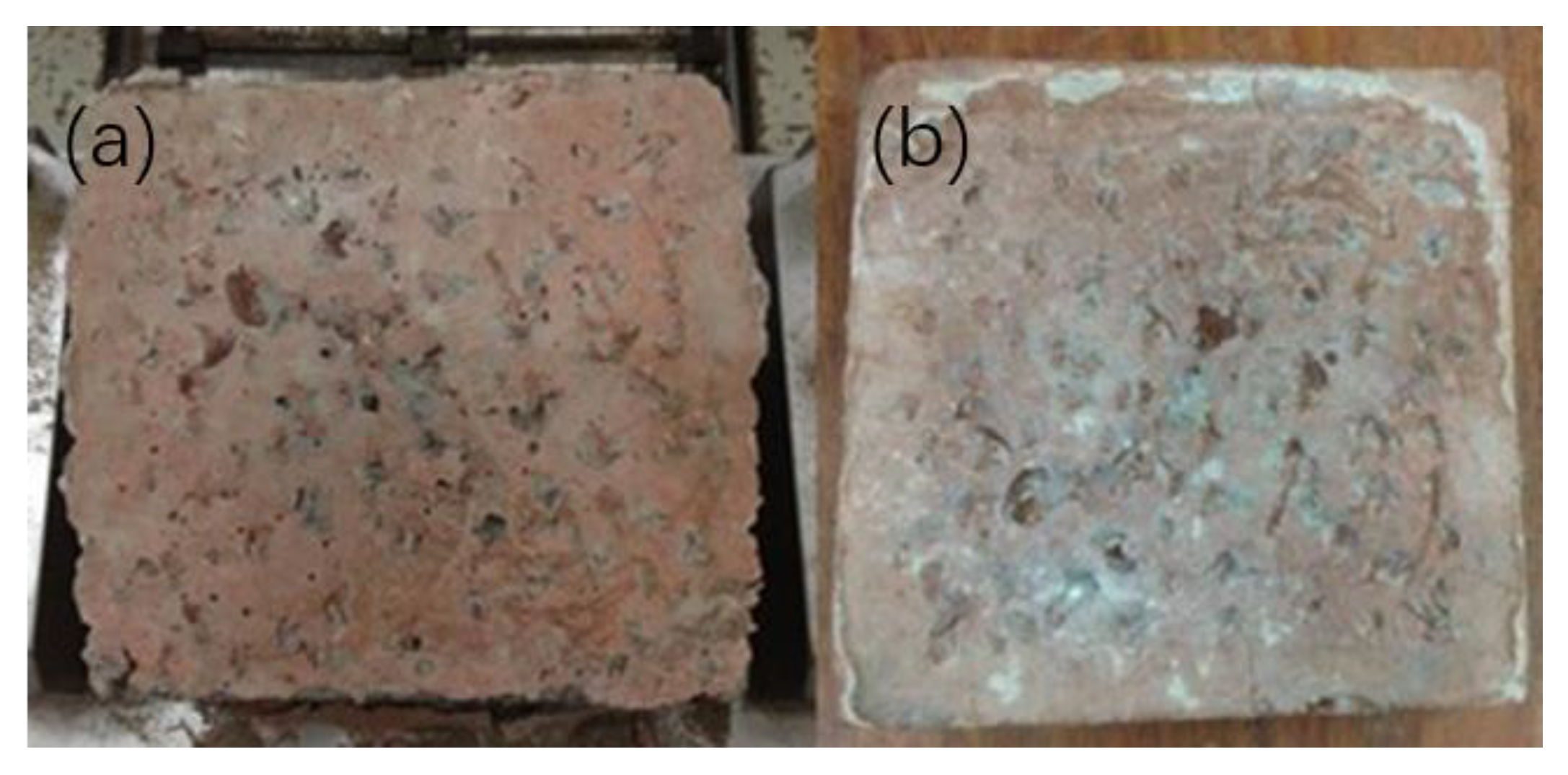

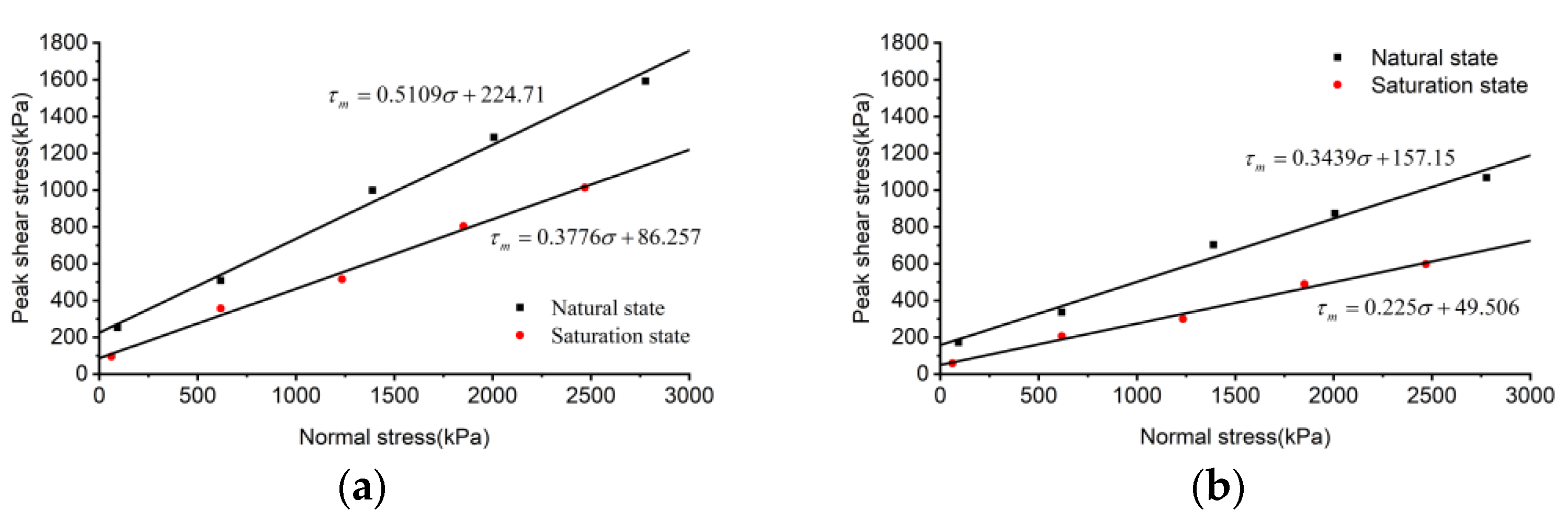
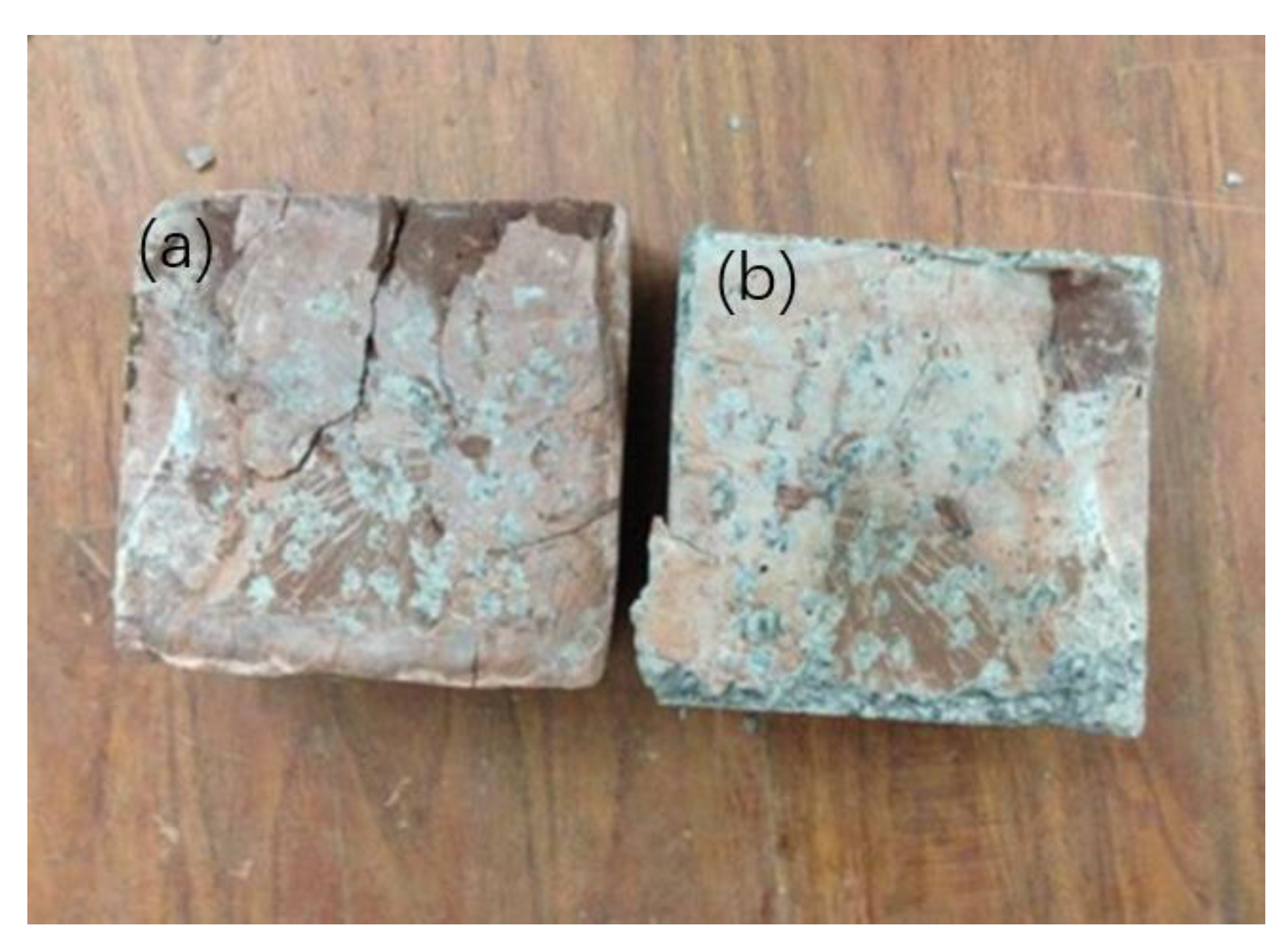
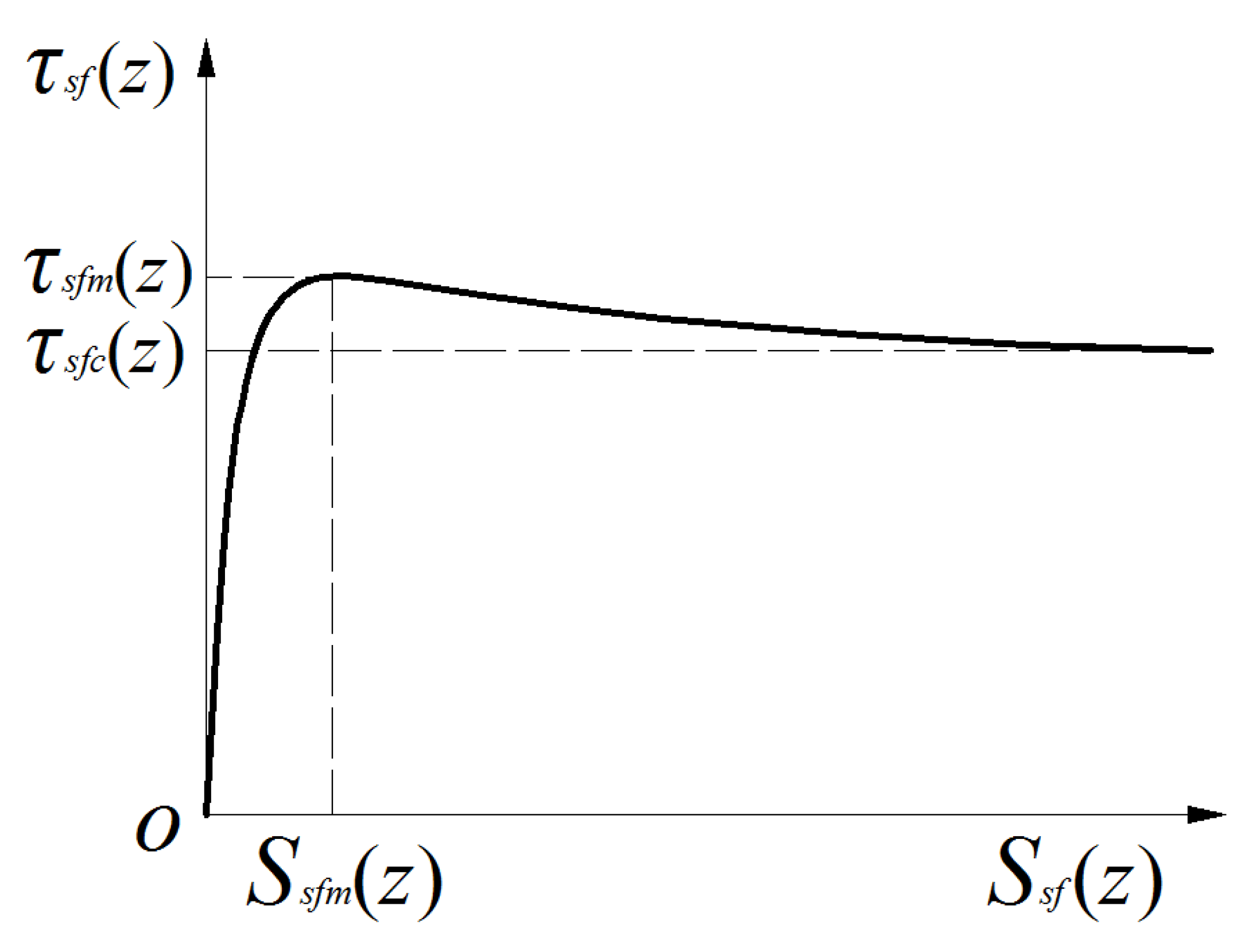

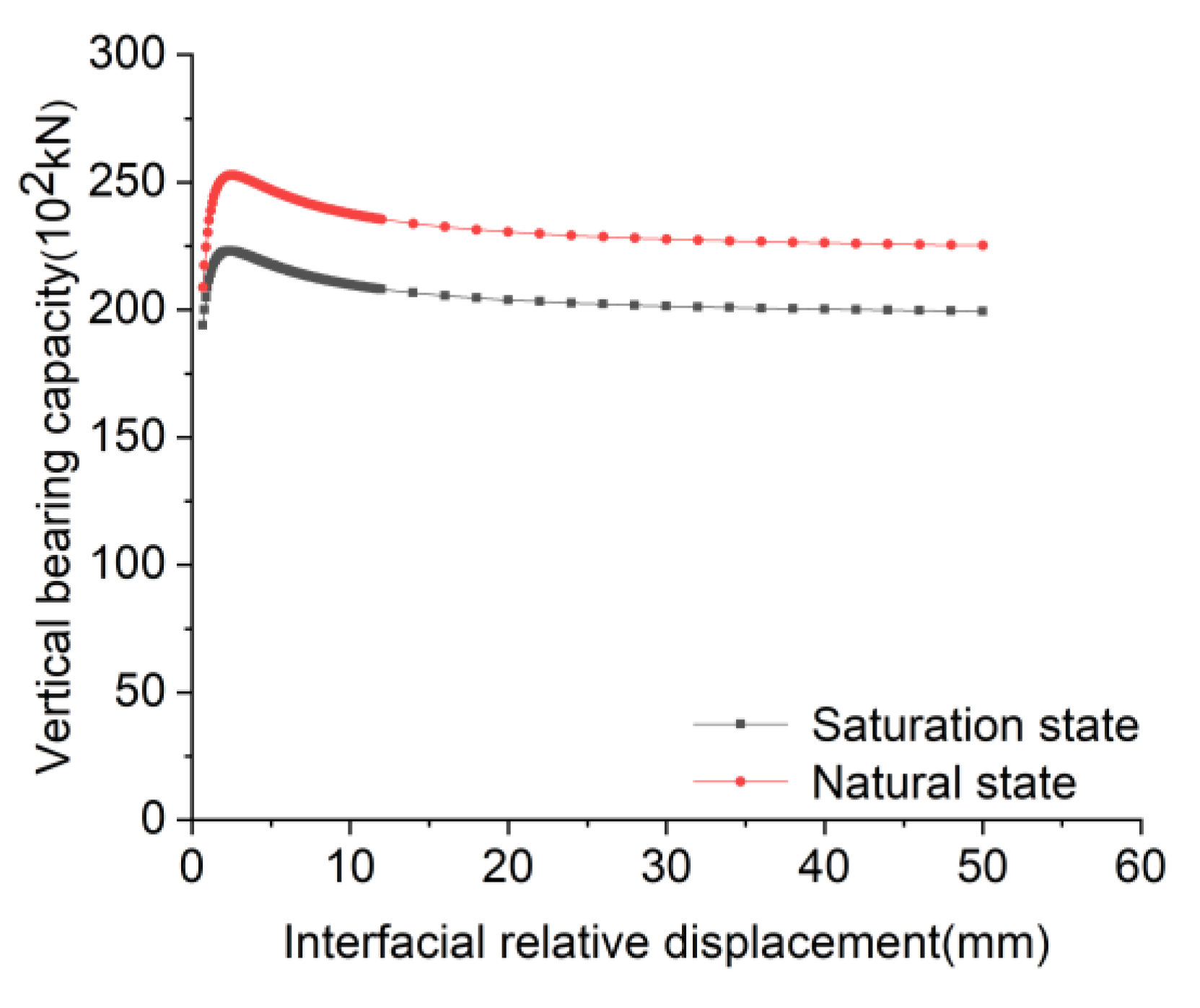

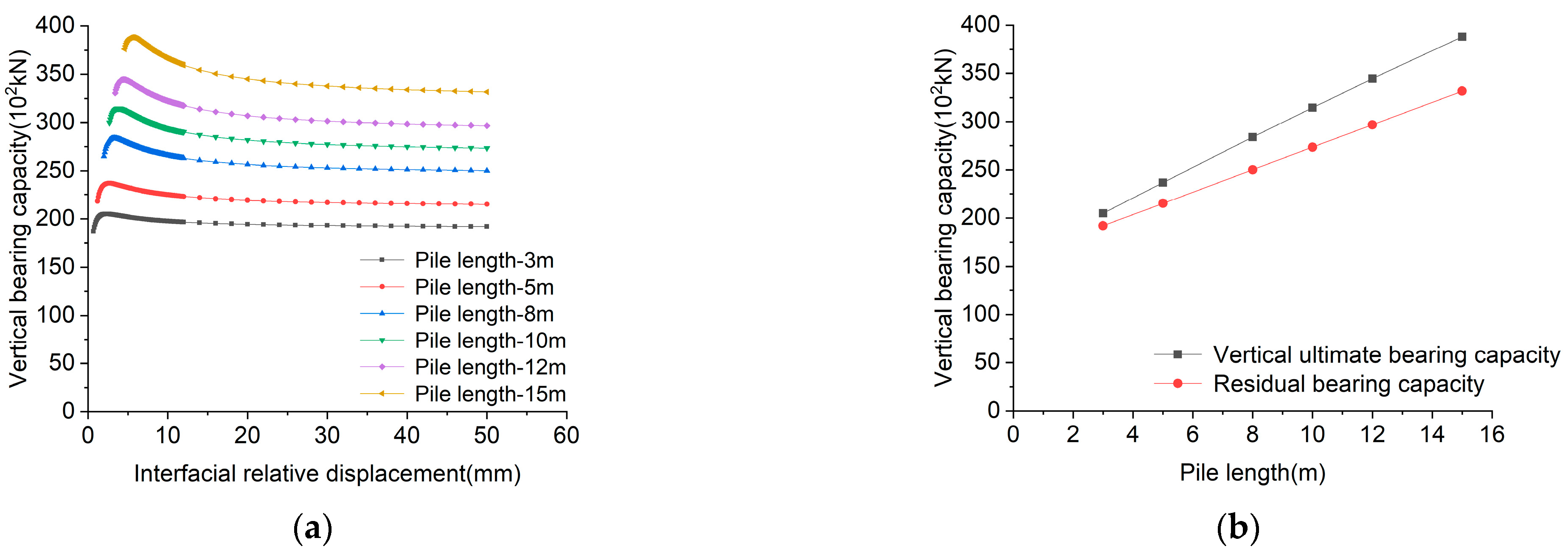

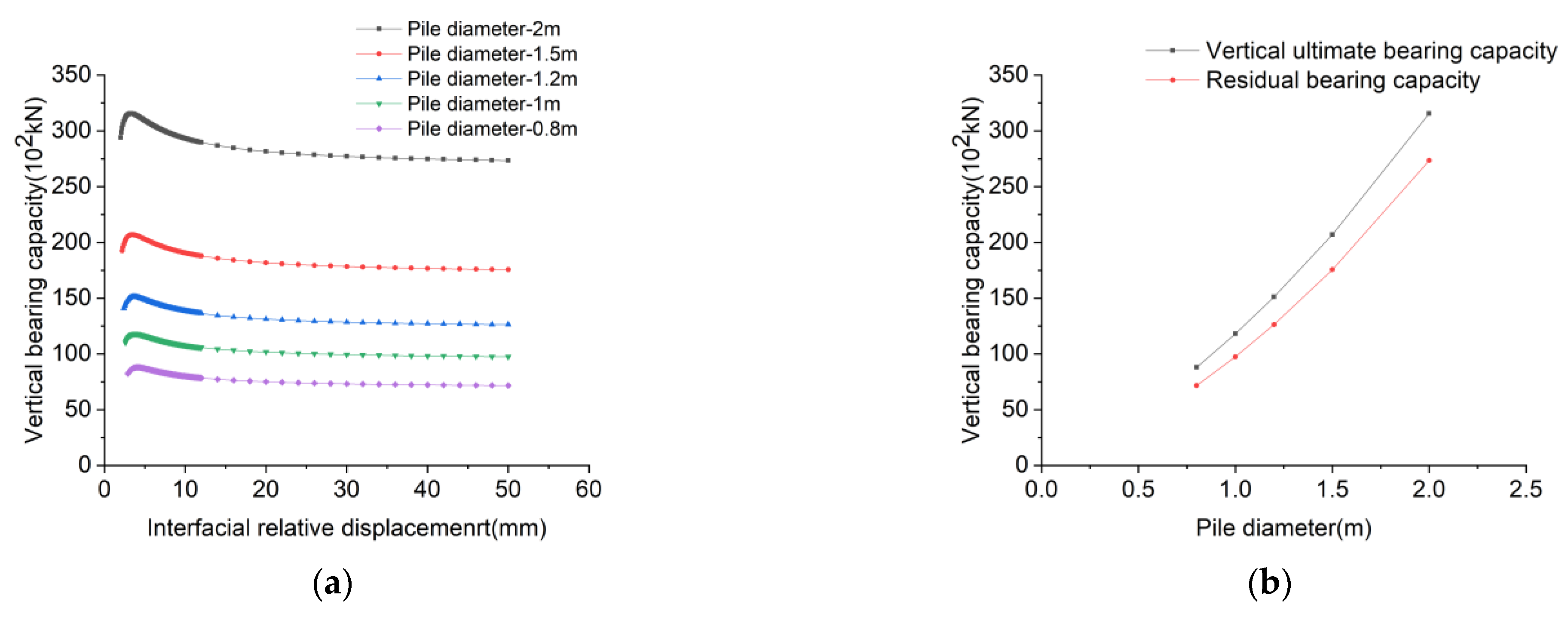
| Natural Density (g/cm3) | Saturation Density (g/cm3) | Natural Moisture Content (%) | Cohesion (MPa) | Internal Friction Angle (°) | ||
|---|---|---|---|---|---|---|
| Natural State | Saturation State | Natural State | Saturation State | |||
| 2.44 | 2.72 | 3.46 | 5.17 | 3.84 | 39.97 | 37.78 |
| Interfacial State | Pile Side Positive Pressure σ (KPa) | α (m kPa−1) | β (kPa−1) | γ (kPa−1) | |||
|---|---|---|---|---|---|---|---|
| Native state | 93 | 1.40 × 10−9 | 1.26 × 10−6 | 2.80 × 10−7 | 1.79 | 3.21 | 0.71 |
| 617 | 7.54 × 10−10 | 6.25 × 10−7 | 1.33 × 10−7 | 1.82 | 3.18 | 0.68 | |
| 1389 | 3.97 × 10−10 | 3.21 × 10−7 | 7.28 × 10−7 | 1.77 | 3.23 | 0.73 | |
| 2006 | 3.52 × 10−10 | 2.48 × 10−7 | 5.36 × 10−8 | 1.81 | 3.19 | 0.69 | |
| 2778 | 3.18 × 10−10 | 1.99 × 10−7 | 4.25 × 10−8 | 1.82 | 3.18 | 0.68 | |
| Saturation State | 62 | 3.41 × 10−9 | 3.08 × 10−6 | 5.42 × 10−7 | 1.96 | 3.04 | 0.54 |
| 617 | 1.11 × 10−9 | 8.69 × 10−7 | 1.56 × 10−7 | 1.95 | 3.05 | 0.55 | |
| 1235 | 8.78 × 10−10 | 5.89 × 10−7 | 1.04 × 10−7 | 1.97 | 3.03 | 0.53 | |
| 1852 | 6.12 × 10−10 | 3.84 × 10−7 | 7.22 × 10−8 | 1.92 | 3.08 | 0.58 | |
| 2469 | 5.17 × 10−10 | 2.99 × 10−7 | 5.38 × 10−8 | 1.95 | 3.05 | 0.55 |
Disclaimer/Publisher’s Note: The statements, opinions and data contained in all publications are solely those of the individual author(s) and contributor(s) and not of MDPI and/or the editor(s). MDPI and/or the editor(s) disclaim responsibility for any injury to people or property resulting from any ideas, methods, instructions or products referred to in the content. |
© 2023 by the authors. Licensee MDPI, Basel, Switzerland. This article is an open access article distributed under the terms and conditions of the Creative Commons Attribution (CC BY) license (https://creativecommons.org/licenses/by/4.0/).
Share and Cite
Abi, E.; Shen, L.; Liu, M.; Du, H.; Shu, D.; Han, Y. Calculation Model of Vertical Bearing Capacity of Rock-Embedded Piles Based on the Softening of Pile Side Friction Resistance. J. Mar. Sci. Eng. 2023, 11, 939. https://doi.org/10.3390/jmse11050939
Abi E, Shen L, Liu M, Du H, Shu D, Han Y. Calculation Model of Vertical Bearing Capacity of Rock-Embedded Piles Based on the Softening of Pile Side Friction Resistance. Journal of Marine Science and Engineering. 2023; 11(5):939. https://doi.org/10.3390/jmse11050939
Chicago/Turabian StyleAbi, Erdi, Li Shen, Mingwei Liu, Hongbo Du, Dan Shu, and Yafeng Han. 2023. "Calculation Model of Vertical Bearing Capacity of Rock-Embedded Piles Based on the Softening of Pile Side Friction Resistance" Journal of Marine Science and Engineering 11, no. 5: 939. https://doi.org/10.3390/jmse11050939
APA StyleAbi, E., Shen, L., Liu, M., Du, H., Shu, D., & Han, Y. (2023). Calculation Model of Vertical Bearing Capacity of Rock-Embedded Piles Based on the Softening of Pile Side Friction Resistance. Journal of Marine Science and Engineering, 11(5), 939. https://doi.org/10.3390/jmse11050939






